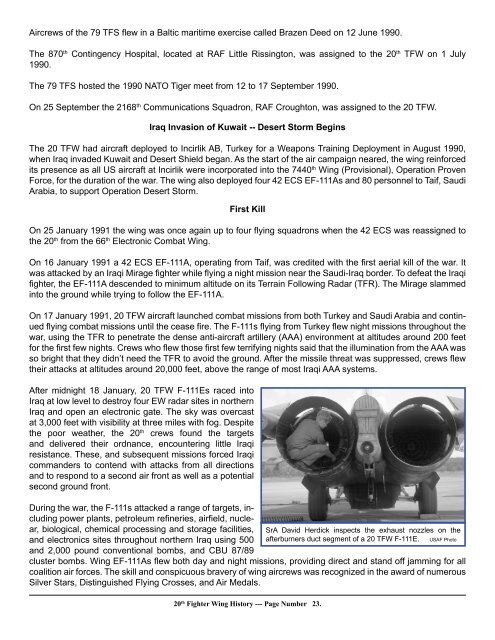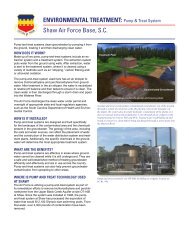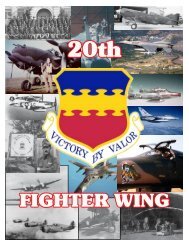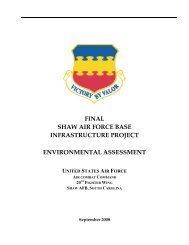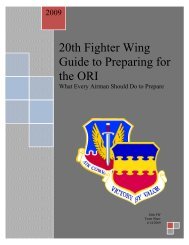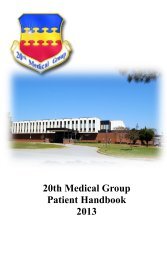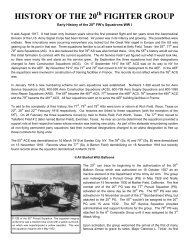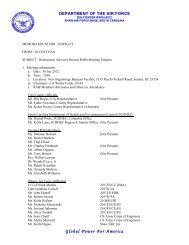HISTORY OF THE 20th FIGHTER WING - Shaw Air Force Base
HISTORY OF THE 20th FIGHTER WING - Shaw Air Force Base
HISTORY OF THE 20th FIGHTER WING - Shaw Air Force Base
Create successful ePaper yourself
Turn your PDF publications into a flip-book with our unique Google optimized e-Paper software.
<strong>Air</strong>crews of the 79 TFS flew in a Baltic maritime exercise called Brazen Deed on 12 June 1990.<br />
The 870 th Contingency Hospital, located at RAF Little Rissington, was assigned to the 20 th TFW on 1 July<br />
1990.<br />
The 79 TFS hosted the 1990 NATO Tiger meet from 12 to 17 September 1990.<br />
On 25 September the 2168 th Communications Squadron, RAF Croughton, was assigned to the 20 TFW.<br />
Iraq Invasion of Kuwait -- Desert Storm Begins<br />
The 20 TFW had aircraft deployed to Incirlik AB, Turkey for a Weapons Training Deployment in August 1990,<br />
when Iraq invaded Kuwait and Desert Shield began. As the start of the air campaign neared, the wing reinforced<br />
its presence as all US aircraft at Incirlik were incorporated into the 7440 th Wing (Provisional), Operation Proven<br />
<strong>Force</strong>, for the duration of the war. The wing also deployed four 42 ECS EF-111As and 80 personnel to Taif, Saudi<br />
Arabia, to support Operation Desert Storm.<br />
First Kill<br />
On 25 January 1991 the wing was once again up to four flying squadrons when the 42 ECS was reassigned to<br />
the 20 th from the 66 th Electronic Combat Wing.<br />
On 16 January 1991 a 42 ECS EF-111A, operating from Taif, was credited with the first aerial kill of the war. It<br />
was attacked by an Iraqi Mirage fighter while flying a night mission near the Saudi-Iraq border. To defeat the Iraqi<br />
fighter, the EF-111A descended to minimum altitude on its Terrain Following Radar (TFR). The Mirage slammed<br />
into the ground while trying to follow the EF-111A.<br />
On 17 January 1991, 20 TFW aircraft launched combat missions from both Turkey and Saudi Arabia and continued<br />
flying combat missions until the cease fire. The F-111s flying from Turkey flew night missions throughout the<br />
war, using the TFR to penetrate the dense anti-aircraft artillery (AAA) environment at altitudes around 200 feet<br />
for the first few nights. Crews who flew those first few terrifying nights said that the illumination from the AAA was<br />
so bright that they didn’t need the TFR to avoid the ground. After the missile threat was suppressed, crews flew<br />
their attacks at altitudes around 20,000 feet, above the range of most Iraqi AAA systems.<br />
After midnight 18 January, 20 TFW F-111Es raced into<br />
Iraq at low level to destroy four EW radar sites in northern<br />
Iraq and open an electronic gate. The sky was overcast<br />
at 3,000 feet with visibility at three miles with fog. Despite<br />
the poor weather, the 20 th crews found the targets<br />
and delivered their ordnance, encountering little Iraqi<br />
resistance. These, and subsequent missions forced Iraqi<br />
commanders to contend with attacks from all directions<br />
and to respond to a second air front as well as a potential<br />
second ground front.<br />
During the war, the F-111s attacked a range of targets, including<br />
power plants, petroleum refineries, airfield, nuclear,<br />
biological, chemical processing and storage facilities,<br />
and electronics sites throughout northern Iraq using 500<br />
and 2,000 pound conventional bombs, and CBU 87/89<br />
cluster bombs. Wing EF-111As flew both day and night missions, providing direct and stand off jamming for all<br />
coalition air forces. The skill and conspicuous bravery of wing aircrews was recognized in the award of numerous<br />
Silver Stars, Distinguished Flying Crosses, and <strong>Air</strong> Medals.<br />
20 th Fighter Wing History --- Page Number 2 .<br />
SrA David Herdick inspects the exhaust nozzles on the<br />
afterburners duct segment of a 20 TFW F-111E. USAF Photo


